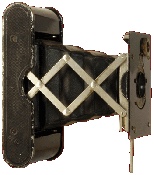The Camera Hanging on the Wall
I had finished the revisions for The Burning Bride, the second book in my Delafield & Malloy Investigation series. Or at least I thought I had.
Right before I went to sleep that night, I remembered that my main character (Louisa) takes a Vest Pocket Kodak (VPK) with her on a trip, but when catastrophe strikes, the camera disappears from the story. I reminded myself to fix this omission before printing the book for my proofreader.
 VPK Photo courtesy of licm.org.uk
VPK Photo courtesy of licm.org.uk
The next morning when I woke up at five o’clock (begging the dream world to take me back for another hour), I thought of Chekov’s famous rule for writing: “If in the first act you have hung a pistol on the wall, then in the following one it should be fired. Otherwise don’t put it there.”
So I had to not only make sure the camera didn’t disappear from the story; Louisa needed to shoot a picture with it — a picture that would help her turn the tables on her enemies.
When I started writing the book, I was delighted to discover that Louisa, a society writer for a prestigious Manhattan newspaper, could take a camera with her on her trip to St. Augustine, Florida, in 1914 and it wasn’t one of those big clunky things, requiring a tripod. There was no need for the photographer to stick her head under a cloth or worry about developing plates. The VPK uses a film cartridge, similar to the ones those of us who were born before the advent of digital photography remember.
We can thank George Eastman for inventing film. The first film was “paper film” invented in 1885. He switched to celluloid film by 1889. By the 1900s he had created smaller portable cameras, including the Brownie, that could be operated by anyone. The VPKs, which could be folded into a 1-inch by 2 1/2-inch by 4 3/4-inch size were popular among soldiers in World War I.
According to an article from the Science + Media Museum in England, “Many soldiers bought cameras to record their travels and experiences. The Vest Pocket Kodak was by far the most popular choice, particularly with American ‘doughboys’. It was widely advertised as ‘The Soldier’s Kodak’ and owners were encouraged to ‘Make your own picture record of the War’. Sales figures rocketed. In 1914 about 5,500 VPKs were sold in Britain. The following year, this increased to over 28,000.”
An article on the Science + Media Museum website has some wonderful examples of pics taken by soldiers. Here’s a picture of British Troops in World War I; from an article in Brittanica by Michael Ray. Was it taken by one of the soldiers? Most likely.
